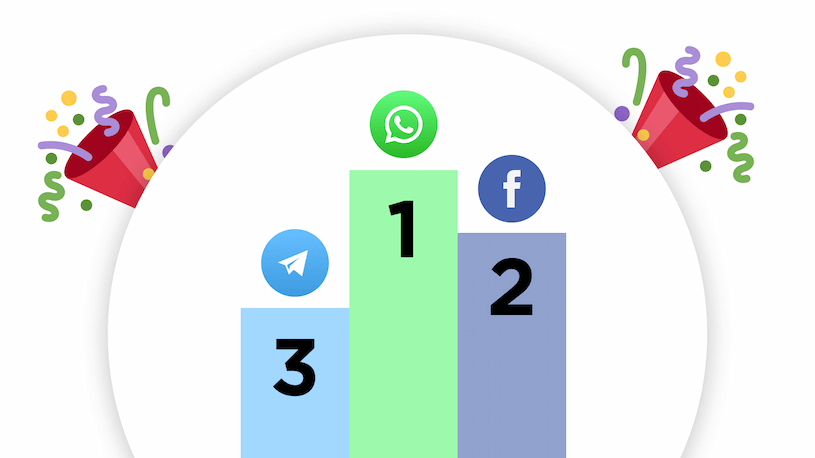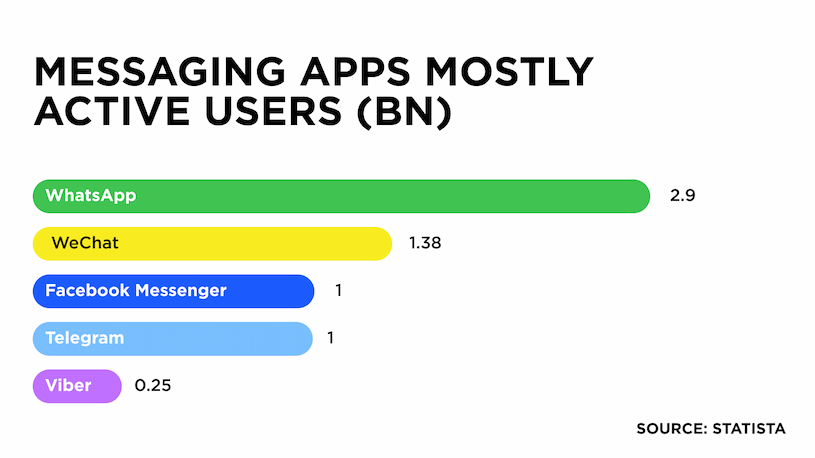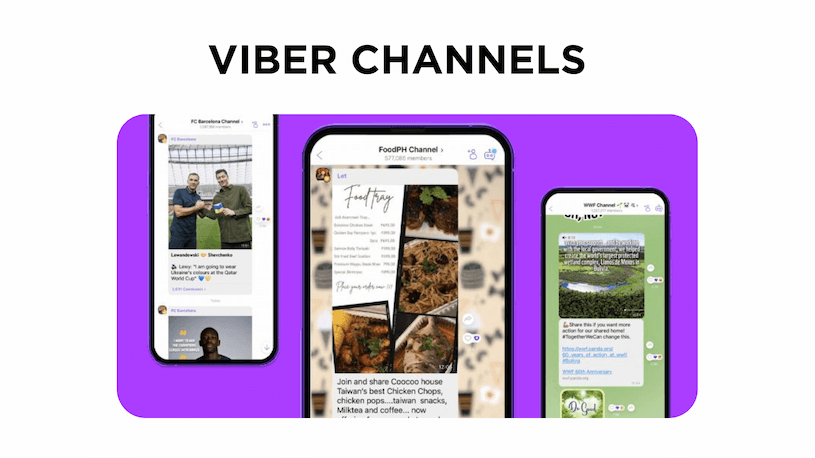Most Popular Messaging Apps: A Comprehensive Overview
Exploring the messengers with the largest number of users.

Over the past few years, the most popular messaging apps, such as WhatsApp, Telegram, and Facebook Messenger, have undergone a lot of changes. Now they offer their users a diverse array of tools for seamless connectivity, content sharing, and collaboration. From private conversations with friends to group chats with co-workers and branded channels, the platforms have turned into indispensable tools for both personal and professional communication. In the blog post, we'll explore the top messaging platforms, their key functionalities, user demographics, and future trends.
Table of contents:
How many people use top messaging apps?
Some of the most popular messaging apps have become an integral part of our daily communication habits, with an ever-increasing number of users worldwide. As of 2025, the total number of individuals using this type of communication channel has surpassed the astonishing mark of 5 billion. This figure includes a wide range of platforms, from popular ones like WhatsApp, Facebook Messenger, WeChat, and Telegram to more regionally specific apps that cater to diverse cultural and linguistic preferences. Various factors, such as the increasing accessibility of smartphones, improved internet connectivity, and the evolving nature of communication technology, contribute to the growth of messaging app users.

WhatsApp: the most popular messenger globally
A user base exceeding 2.9 billion active monthly users signifies WhatsApp's unparalleled global reach. The messenger has seamlessly integrated itself into the everyday communication practices of people across diverse countries. Originally built by US developers, today, WhatsApp is extremely popular in Europe, Latin America, Africa, and Asia as well.
WhatsApp is more than just a messaging application as it offers secure conversations, voice and video calls, and more. With recent updates, users can send disappearing messages and enjoy more functional end-to-end encrypted group chats. The platform's widespread adoption is explained by a compelling array of features and updates that consistently improve the user experience. It is also a popular tool among brands for customer communication, thanks to WhatsApp integrations with CRM that allow seamless management of dialogues within a corporate digital ecosystem.
WhatsApp users demographics
WhatsApp, a globally recognized messaging application, boasts a user base that spans a wide range of age groups. According to Demandsage, the app is especially popular among the 26-35 segment, which accounts for 27% of the app's active user base in the US.
Facebook Messenger: among the most popular messaging apps in Europe
Facebook Messenger has over 1 billion users worldwide. Its popularity can be attributed to its seamless integration with the broader Facebook ecosystem, which allows users to transition effortlessly between the social media platform and the messaging app. This integration simplifies staying connected with friends and family. Also, the platform enables users to share photos and videos and participate in group chats and video calls.
In recent years, Facebook Messenger has undergone significant enhancements that further improve its user experience and functionality. One notable feature is the introduction of Messenger Rooms. It enables users to create virtual rooms for video calls with up to 50 participants, with no time limit, and the ability to invite people who don’t have a Facebook account.
Additionally, the Messenger has focused on enhancing security and privacy measures. For example, it offers end-to-end encryption for one-on-one conversations along with advanced settings to control message visibility and data sharing. These ongoing developments make Facebook Messenger popular among users who seek a comprehensive and user-friendly messaging experience within the Facebook ecosystem.
Facebook Messenger demographics
In the US, the age group of 25-34 years shows the highest usage rate of Facebook Messenger at 32%, according to DataReportal. This is closely followed by the 18-24 and 35-44 age groups. These statistics highlight the appeal of Facebook Messenger across different age groups, particularly among those in their mid-twenties to mid-forties.
Telegram: one of the best free texting apps
Telegram has garnered a loyal user base of 1 billion people, making it one of the most popular messaging apps. One of Telegram's key selling points is its strong emphasis on privacy and security features. These include end-to-end encryption for secret chats, self-destructing messages, and the ability to set message expiration timers. Such robust privacy measures have significantly contributed to Telegram's popularity among users seeking a more secure alternative to mainstream messaging platforms.
Telegram stands out for its robust set of features designed to enhance communication and user experience. It supports large group chats, with the capacity to host up to 200,000 members, making it ideal for communities and organizations to engage on a big scale. The instant messaging software’s cloud-based nature allows seamless synchronization across multiple devices, ensuring users can access their conversations and media from anywhere. Additionally, Telegram boasts a versatile bot platform that enables users to automate tasks, play games, and make purchases within the app.
Telegram's commitment to open-source development and user feedback has fostered a community-driven environment. As a result of this and its rich features, the app remains as a top choice among users looking for a comprehensive and secure messaging tool tailored to their digital communication needs.
Telegram users demographics
Younger demographic represents a significant portion of Telegram’s user base, indicating the platform’s appeal to younger generations. As per Demandsage report, the messaging app is highly popular among the users of the 25-44 age group, which accounts for 53% of the platform's US user base.
Viber: still popular and going strong
With over 1 billion registered users, Viber continues to stay popular and relevant in the messaging landscape. It offers a wide array of features and stands out for its provision of free voice and video calls, end-to-end encryption for secure communication, and a vast collection of stickers. A couple of years ago, the messenger introduced channels that connect users with content creators and brands. These features have contributed to Viber's appeal, attracting users who value both functionality and entertainment in their messaging experience.

Viber has a strong foothold in regions like Europe, the Middle East, and parts of Asia, which solidifies its position among top messaging apps. The platform's localized approach, support for multiple languages, and cultural relevance attracts users from various regions, fostering a sense of community and connection. Recent updates from Viber have focused on enhancing user engagement and convenience, introducing features like disappearing messages, new interactive sticker packs, and improvements to group chats. Consequently, the app remains a popular option among people who want a reliable and feature-rich instant messaging software.
WeChat: the giant from China
WeChat is a multifunctional super app that has a remarkable user base of nearly 1.4 billion users. Its capabilities go beyond traditional messaging platforms: in addition to text and media sharing, WeChat serves as a comprehensive ecosystem offering social media features, mobile payments, gaming, news, and even business services, making it an indispensable tool for daily life in China and beyond. The app's integration of multiple functions under one platform has revolutionized the way users communicate, socialize, shop, and make transactions.
While WeChat's popularity in China is unparalleled, the platform's expansion into international markets has garnered a sizable user base outside China. Despite facing challenges in some regions due to data privacy and censorship concerns, WeChat's influence continues to grow globally, underscoring its significance as a versatile and omnipresent messaging platform with wide functionalities tailored to the needs of its diverse user base.
Things to consider when choosing a messaging app
If you’re deciding on a messaging tool to use, whether for personal goals or to connect your brand with clients, it is wise to consider the following aspects to pick the most suitable option.

- Popularity: check what age groups, interests, and regions are mostly represented by the app’s audience, as well as its general popularity. This will ensure connectivity with your audience and a wider network of potential clients.
- Available features: consider what functionality is required for your activities within the messaging app. Whether it is video calls, file sharing, group chats, and analytics that align with your communication needs.
- Security: check the app's security measures, data handling practices, and privacy policy transparency. This will protect your sensitive information and attract security-conscious individuals.
- User experience: consider the application's UI, ease of navigation, and overall user experience for enjoyable use of channels and groups. Also, if you plan to advertise your brand, it is important to review the available advertising options.
- Regular updates: while it is a common practice to provide regular updates and bug fixes among top messaging apps, other software tools with smaller user bases might release new versions of their apps less frequently. Infrequent updates can negatively impact user experience and reduce an app's popularity.
Trends in messaging apps to look forward to
Just as with other digital technologies, the popular messaging apps constantly evolve, incorporating the latest developments and tendencies in tech and lifestyle. Let’s take a look at some of the main ongoing trends in this realm.
Augmented reality
As AR technology becomes more ubiquitous, messengers incorporate more AR features to enhance user engagement and communication. This could enable them to interact in virtual environments, share AR stickers and filters, or even conduct virtual meetings and events within the messaging platform.
AI chatbots
The integration of AI-powered chatbots is expected to become more sophisticated. Already, chatbots are capable of handling tasks like scheduling appointments, making reservations, or providing real-time customer support. In the future, they will be able to provide even more personalized assistance, recommendations, and automated services within messaging apps.
Extensive support for voice and video
Expect advancements in voice and video calling quality: features like 3D audio, spatial audio, and high-definition video calling are likely to become standard in messaging apps, further enhancing the communication experience.

Enhanced security
Due to an increasing emphasis on data privacy and security globally, instant messaging software is likely to introduce even more advanced encryption techniques. They will also offer secure sharing options and improved protection against phishing and malware attacks to safeguard user information and maintain trust.
Collaborative and productivity tools
Having become indispensable tools for business communication, messaging apps are likely to integrate more collaborative features, including shared task lists, document editing, project management tools, and group collaboration spaces. These tools will cater to the needs of remote workers and facilitate collaboration.
By embracing these trends and innovations, messengers will continue to evolve into multifunctional platforms that not only facilitate communication but also offer a diverse range of services to meet the growing demands of users.
Summing things up
It is hardly possible to overlook how digital applications have transformed many aspects of our daily lives, including interactions with friends, family, and colleagues at work. The most popular messengers offer broad functionality, which increases our frequency of using them even more. Through innovation and a focus on user experience, these apps continue to shape the trajectory of modern communication, fostering connections on a global scale.
If you plan to use messaging apps to promote your brand and connect with potential clients, consider employing Umnico omnichannel messaging platform to merge all messengers in one interface and streamline your customer communication efforts. Umnico provides extensive analytics features and supports integrations with various business apps.

Subscribe to Umnico news!
Be the first to get recommendations and up-to-date information
